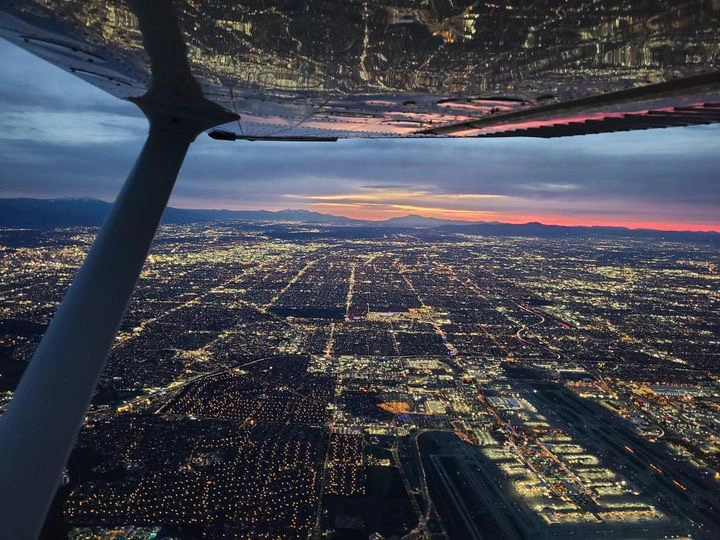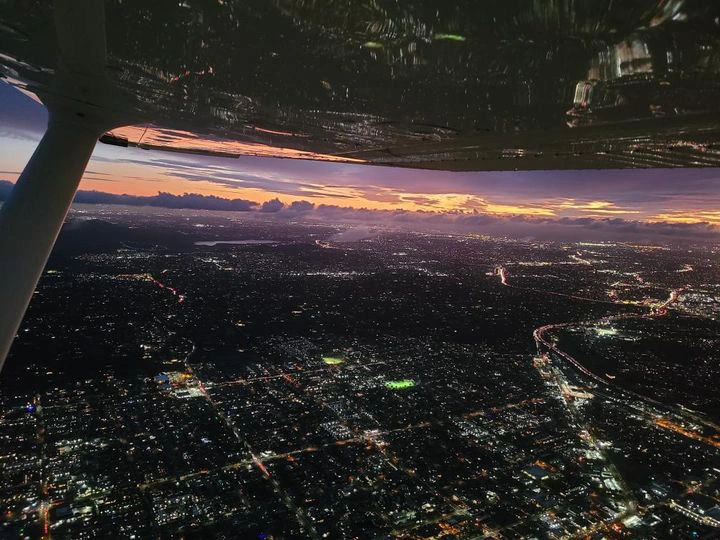If you have ever flown on a plane after the sun has set, then you know the view from the sky is quite dark. Sure, you can see some lights here and there if altitude allows – and it is pretty simple to know whether you are flying over a populated area. If that is what you see as you look out the window, how can a pilot see to navigate the plane?
The difference between flying during the day and flying at night is as stark for pilots as it is for passengers. In fact, pilots who fly after the sun goes down need to have a special set of skills to ensure success.
How do pilots do it? What do pilots see when flying after the sun goes down?
Why Do Pilots Fly At Night?
If flying at night is so difficult, why do pilots do it? Why not stick to daytime travel when it is easier to see everything going on around the aircraft?
There are several reasons why you will see aircraft in the sky at all hours of the day. First, air travel does not stop. There is no downtime in aviation.
Runways and tarmacs do not quiet down at the end of the day even though the inside of the airport may. Planes continue to come and go all throughout the night. There are red-eye flights carrying passengers and an entire network of freight planes that operate 24/7. Shipments of goods going from one location to the next, as well as mail packages for consumers, make their way all around the world while we are sleeping.
Think about it – if pilots did not fly at night, how would you get your overnight delivery?

The Help of Lights When Flying at Night
Planes have headlights so that pilots can see what is in front of them. Unfortunately, they are only effective during takeoffs and landings. Even with the slight illumination offered by the headlights, only darkness is visible when looking out the front window of a cockpit. Nonetheless, pilots safely travel from point A to point B without any trouble. How do they do it? What do pilots see when flying at night?
One thing is for certain—they see lights.
Lights on Aircraft
When looking up from the ground, it is easy to see the flashing lights on aircraft against the dark night sky. Though this allows you to see what is going on up above, it serves a greater purpose for other jets in the sky. Much like a car’s headlights driving on a road at night, the flashing lights on the exterior of the aircraft make it noticeable. These lights are often referred to as anti-collision lights and are located on the bottom of the plane, flashing red or white.
Another set of lights to make the aircraft noticeable are position lights, located on each wing. These alert others to where the wings are, but they also signal the direction a plane is traveling. Again, to avoid a collision.
Consider lights on an aircraft an extra layer of protection in the night sky.
Lights on the Ground
What do pilots see when flying?
Lights on the ground are a significant help to pilots. While they may not make much sense to the average person, to those with flight training, these lights play a huge role in aviation direction. They are able to guide the pilot for takeoffs, landings, and when taxiing around the airport. The FAA makes this a requirement.
The more lights, the more visible the airport will be and the easier it will be to handle air traffic.
Lights for taxiing are often blue, green, and yellow. Blue lights signal the end of the taxiway so that the aircraft does not run off the road. Green lights indicate the center line to help guide the pilot. The yellow lights stop a pilot from taxiing onto a runway in case a plane is taking off or landing. It is considered a hold short line where the pilot waits for direction from the air traffic controller.
The lights for the actual runway are white, yellow, green, and red. They designate the following:
- Green and red lights: runway ends
- White and yellow lights: runway edges
- White lights: touchdown zone
- White and red lights: center line

Visual Flight Rules vs. Instrument Flight Rules
Visual Flight Rules (VFR) directs pilots on how to fly their aircraft when visibility is low. As its name suggests, this involves obtaining a visual reference to the ground. This keeps pilots from coming in contact with obstructions along the course. With VFR, pilots must be able to use either the earth or the horizon as a visual reference. With the vast darkness that surrounds a plane at night, counting on visuals is just not an option.
Instrument Flight Rules (IFR) involve using the navigational system to direct the flight. Developed by the FAA, these rules require that the pilot know how to utilize these advanced instruments so that they can fly safely with little to no visibility. Thanks to modernized cockpits, IFR is often the preferred method for pilots to navigate when flying at night.
Advantages of Flying at Night
Flying at night is a bigger challenge than flying during the day—but it does come with a few advantages that pilots enjoy.
The Views are Amazing
Although it may be dark, seeing cities lit up below can be a beautiful and peaceful sight.
Less Air Traffic
When you travel at night, the airspace is much quieter.
Less Turbulence
Without the sun’s heat creating irregularities in air currents, you can enjoy a much smoother flight.
Believe it or not, flying at night can be easier to navigate once you get the hang of it.
Hone Your Nighttime Flying Skills at CAU
What do pilots see when flying at night?
Learn all about it at California Aeronautical University. We make sure that our pilots have all the training and tools necessary to fly safely in the nighttime sky.
Gain insight into your future in aviation. Request information today.
Ready to soar in your aviation career?
Mr. Matthew A. Johnston has over 23 years of experience serving various roles in education and is currently serving as the President of California Aeronautical University. He maintains memberships and is a supporting participant with several aviation promoting and advocacy associations including University Aviation Association (UAA), Regional Airline Association (RAA), AOPA, NBAA, and EAA with the Young Eagles program. He is proud of his collaboration with airlines, aviation businesses and individual aviation professionals who are working with him to develop California Aeronautical University as a leader in educating aviation professionals.
